Italian Panettone (Giorilli panettone)
Giorilli is considered to be one of the best panettone bakers in the world!! To quote the original recipe website, “This panettone is light as a feather, an enchanting, aromatic, fragrant and infinitely good unfriendliness.“ Who can resist?!?
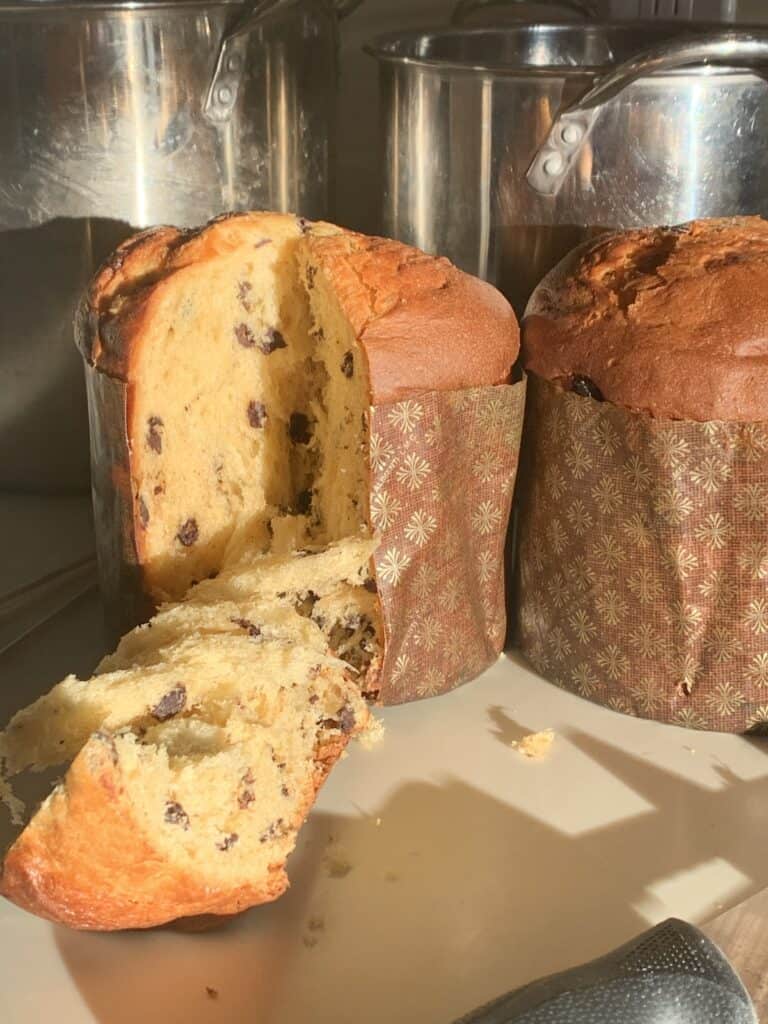
Overview of Panettone Making Process
This is definitely an **advanced** recipe, for those who want a challenge. It is well worth the effort!
You will need an established sourdough starter/levain (can be either liquid or solid, which is called pasta madre). Pasta madre is said to be the better choice, but I have successfully used both (I will always opt for pasta madre now and that will be the subject of another post).
You will also need a standing mixer, panettone cases, and skewers or needles to insert at the bottom of the panettone so you can flip it over after baking to prevent collapsing. It is also highly recommended to have a thermometer to monitor the dough temperature and also a thermometer to gauge/monitor the temperature of the area where you will rise the dough.
The dough is made over 2 days, assuming you have an active pasta madre or liquid starter/levain.
On day 1, you will make the “first dough” and then let it sit for 12 hours (or overnight) and then you will add ingredients to make the “second (ie, final) dough”, which is then ultimately baked.
In addition to your starter being active and healthy, time and temperature control are critical to the success of panettone making.
It has often been said that making a good panettone is 90% about the health and vitality of your starter (levain) and 10% about the proper dough strength and temperature control during fermentation.
The Ingredients: First dough (panettone)

Ingredients for second dough (panettone):
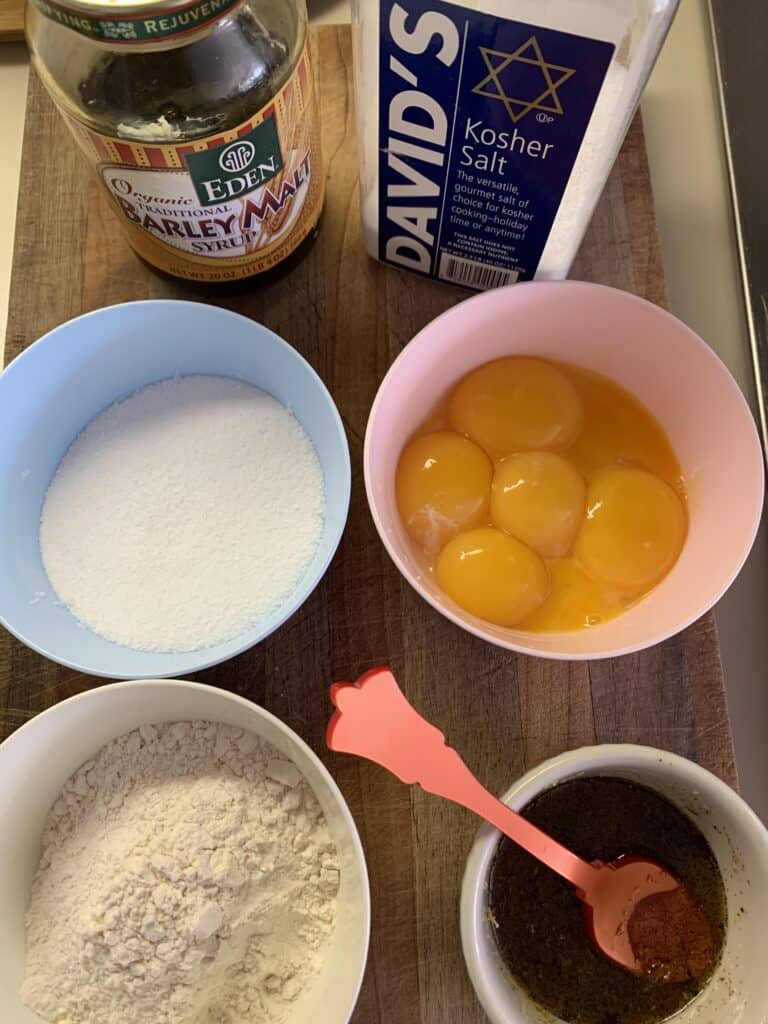
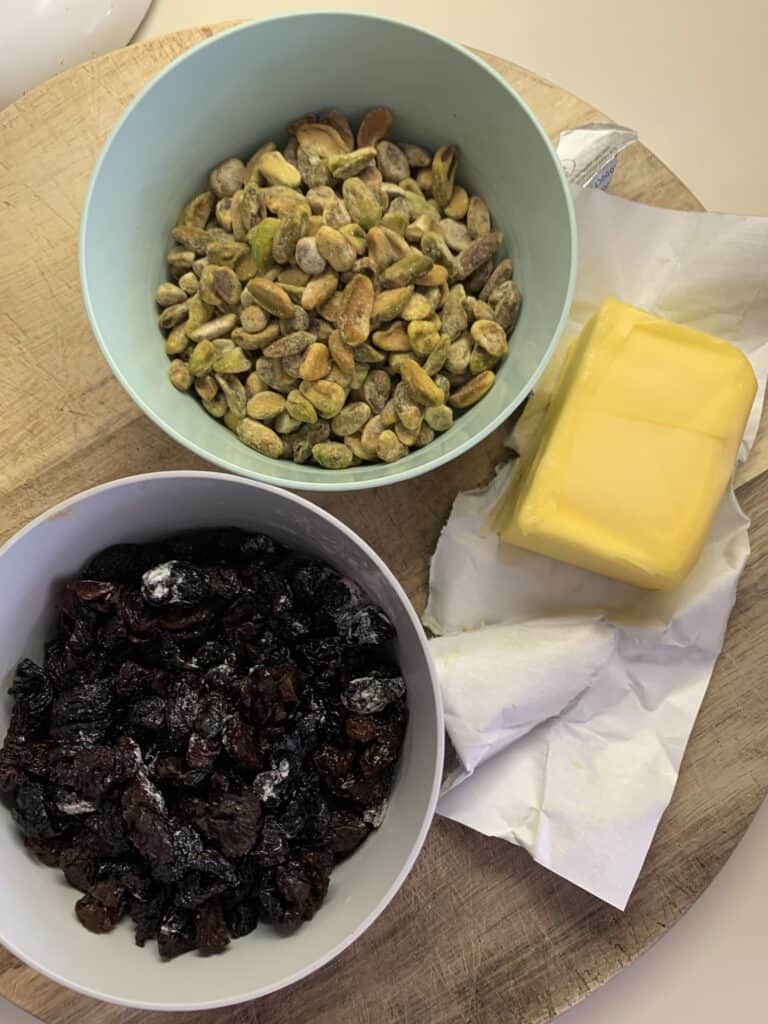
Making the first and second doughs
Below is a very brief overview of making the doughs. Making the first dough (looks like batter initially); when it’s done it, you should be able to pull a windowpane. After the first dough rise and mixing of the second dough, you will add in your mix-ins. Finally, the risen dough is shown, and final baked panettone. Immediately skewer the bottom and hang in large pot or between two chairs.
You will have about 20 seconds to skewer and invert the panettone before it may start to collapse so work quickly!
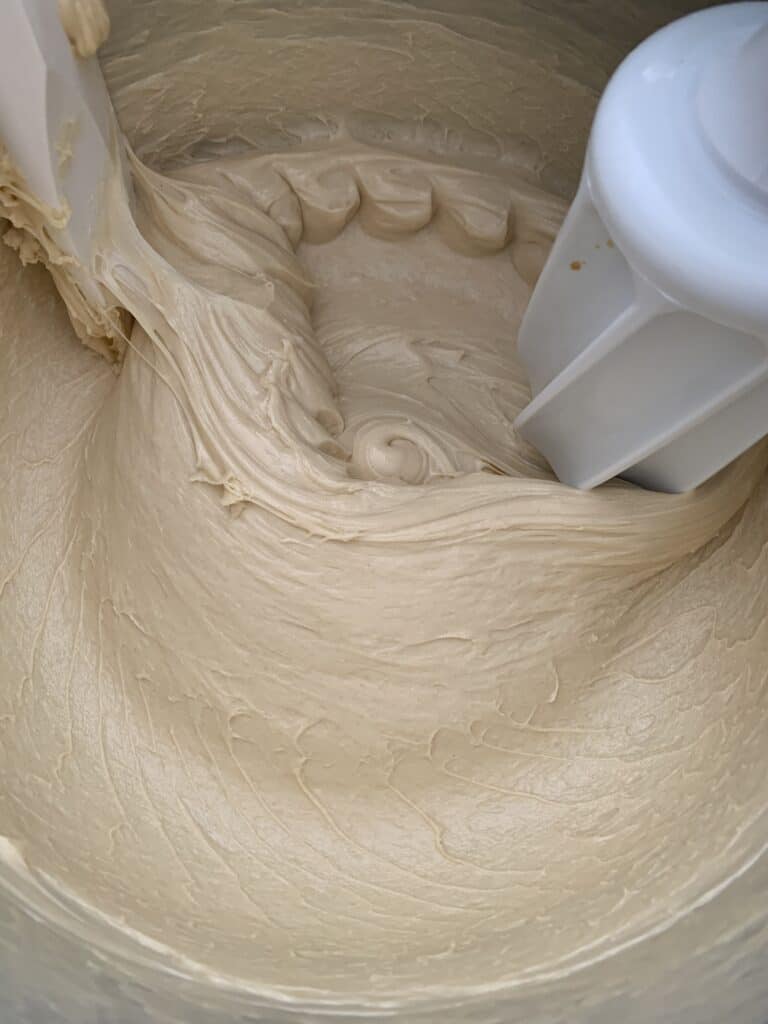
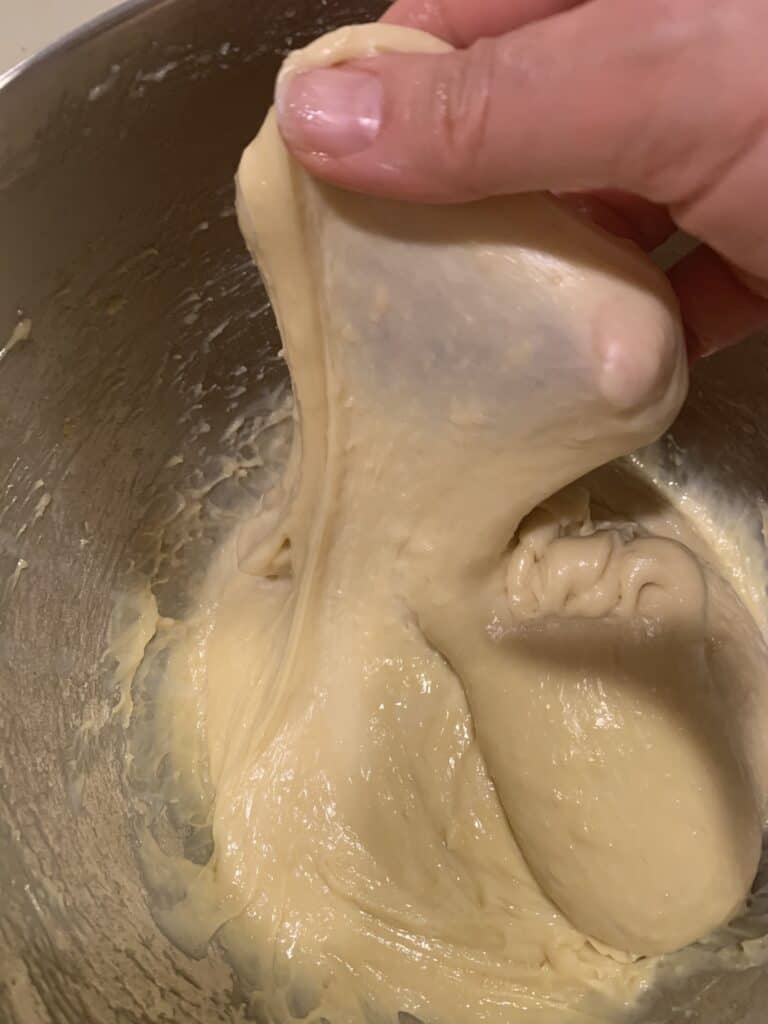
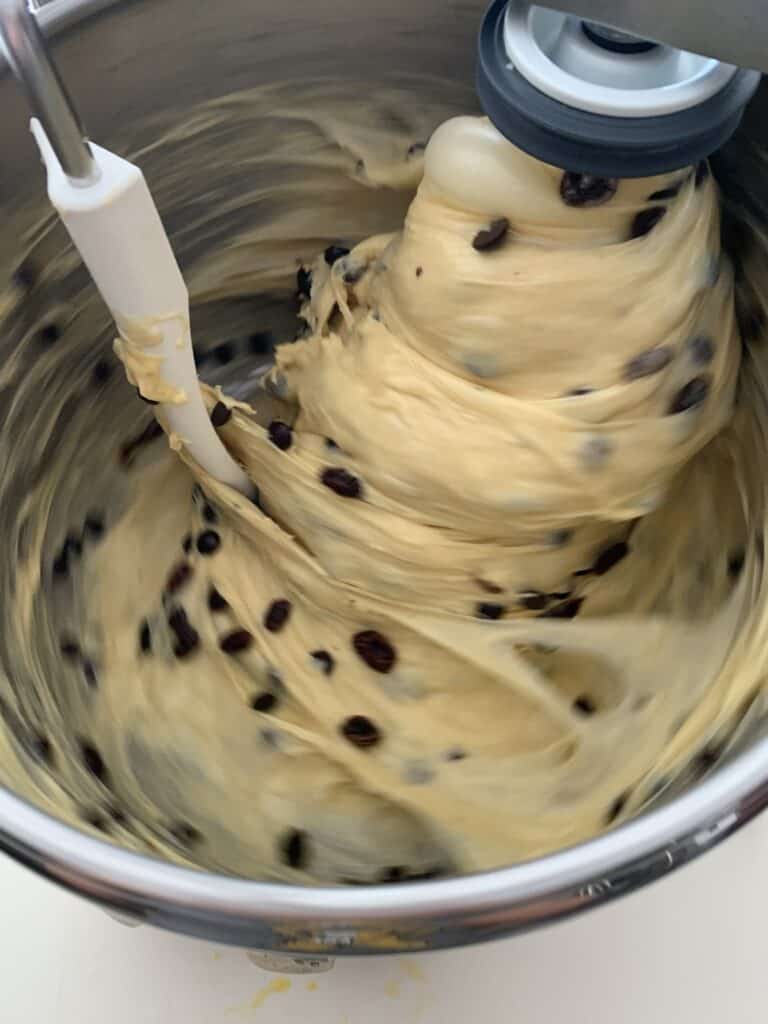
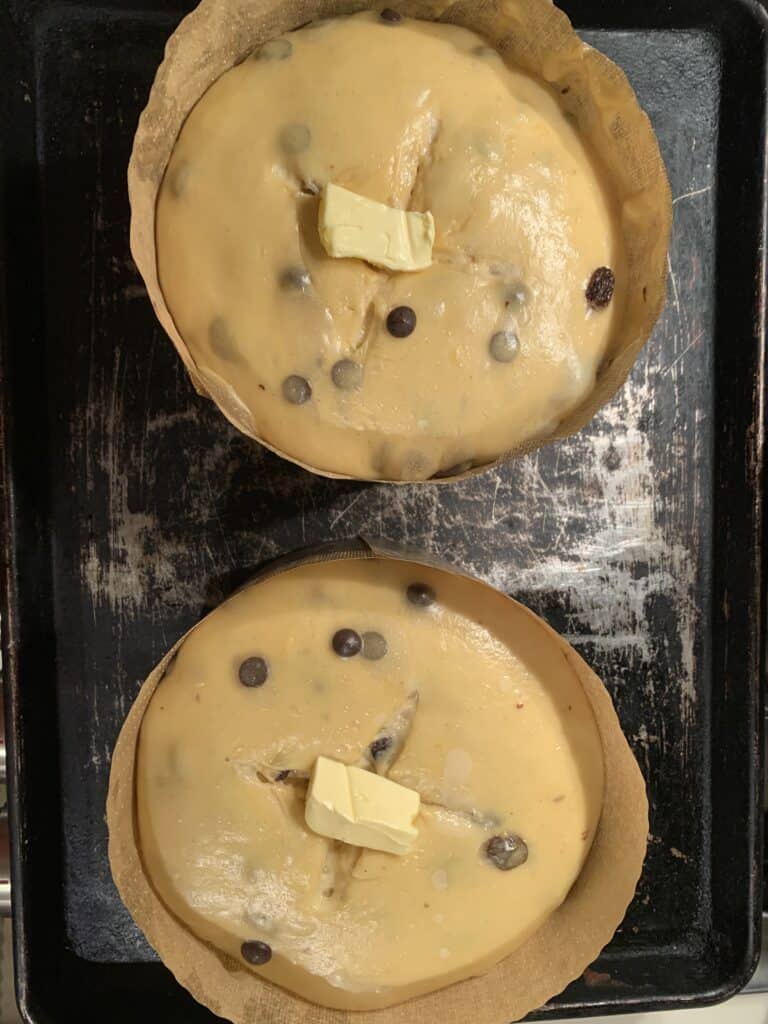
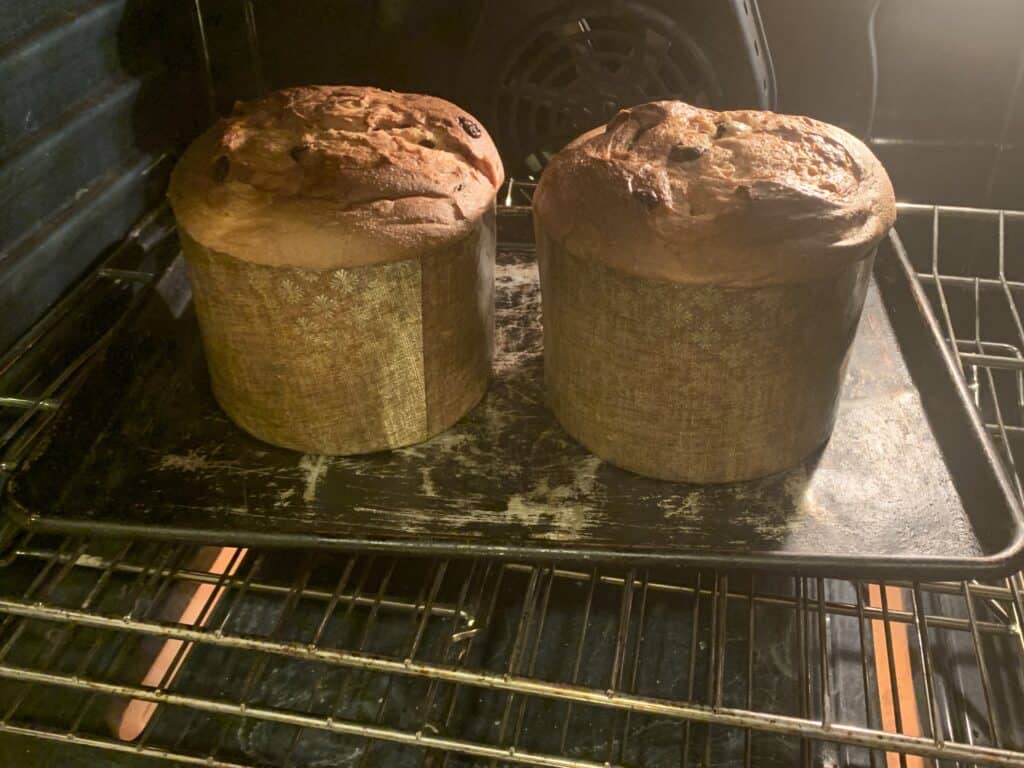
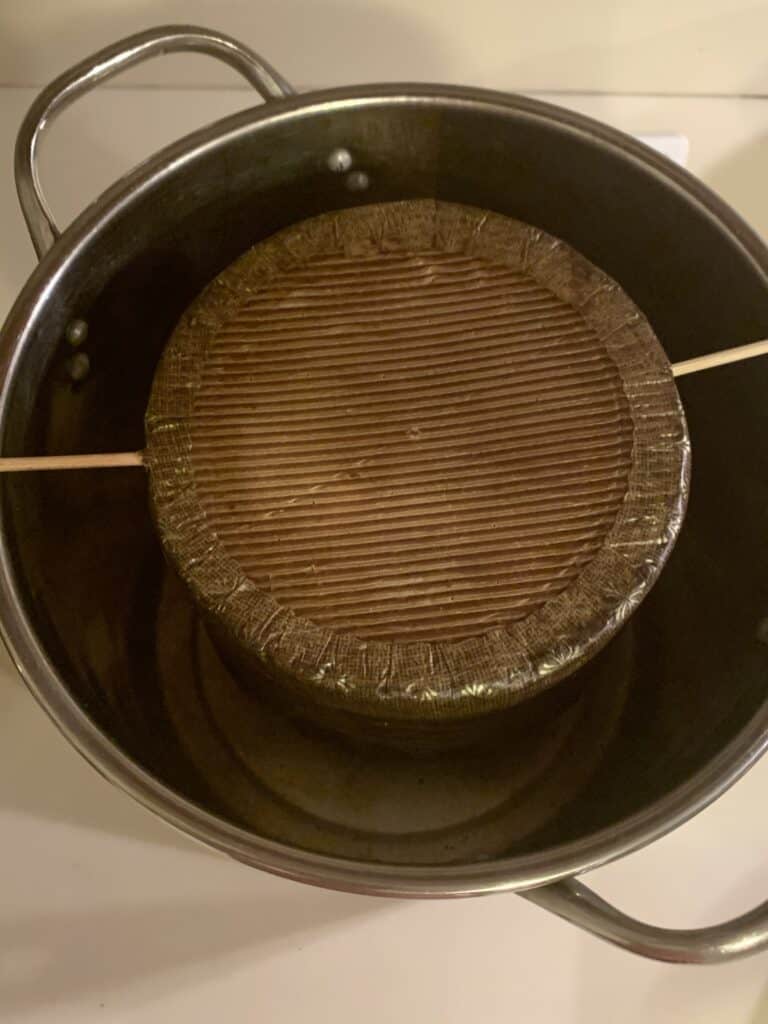
The results are very worthwhile and these make impressive gifts for those who enjoy homemade baked goods!
Panettone: The crumb
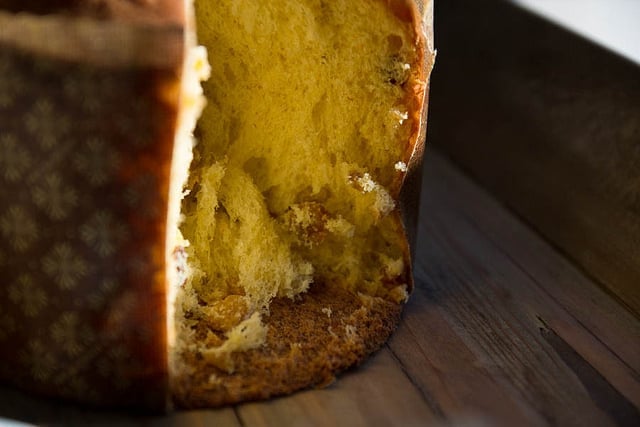
Above and below are crumb shots of the panettone: the goal is getting a beautifully soft and shreddable crumb.
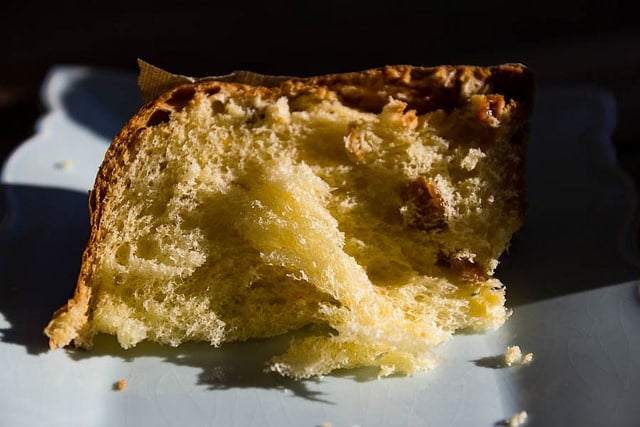
I couldn’t resist including several photos of the inside of the panettones I’ve made over the years; the inside is super soft and shreddable.
The use of natural leavening/starter provides this soft interior and also helps keeps the panettone fresh for days to weeks, depending on the amount of dextrans produced, according to a book by Bread-Editions, called Sourdough Panettone and Viennoiserie. (this book is highly technical and geared toward professional bakers or very serious home bakers.)
The balance of bacteria and yeasts, including the specific strains is a major subject in it’s own right and the reason why panettone masters will refresh their mother dough/pasta madre/starter several times over several days at specific temperatures.

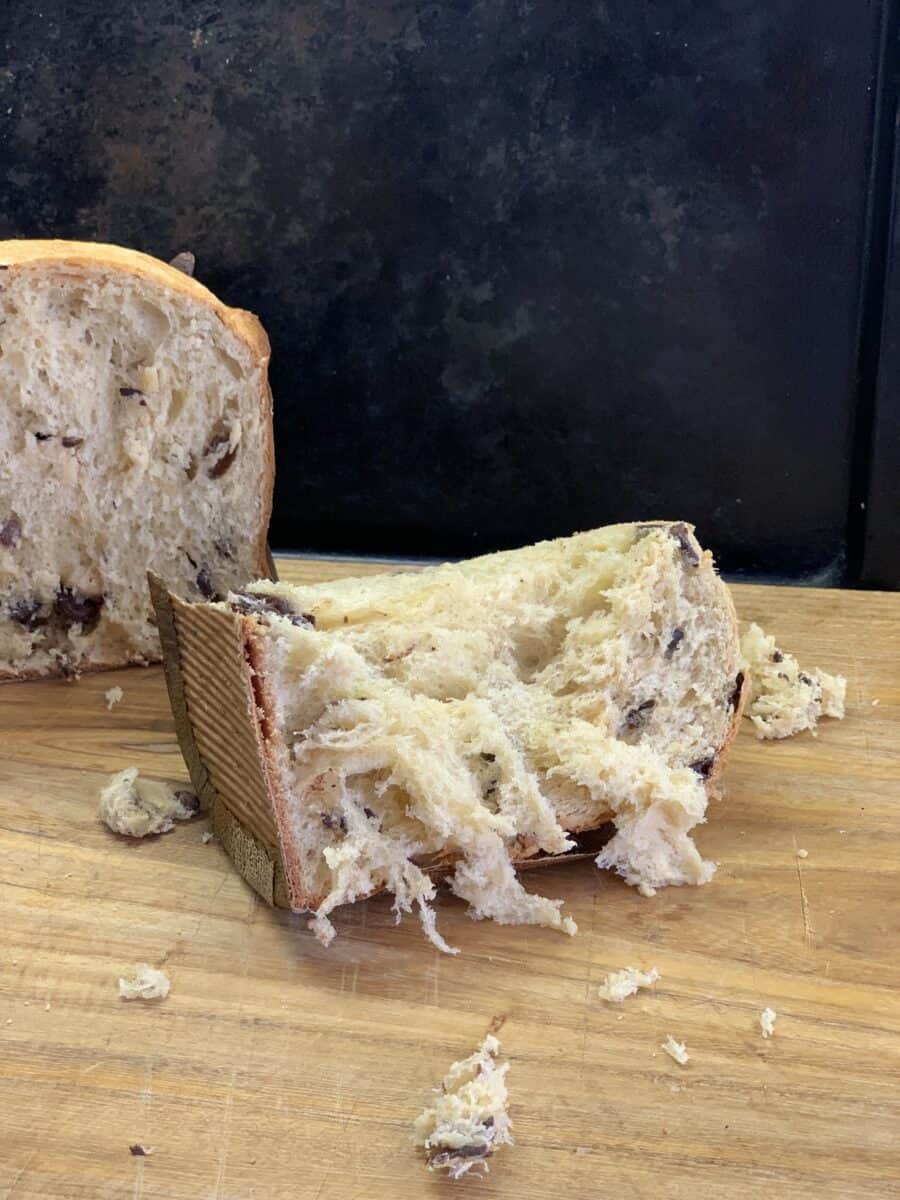
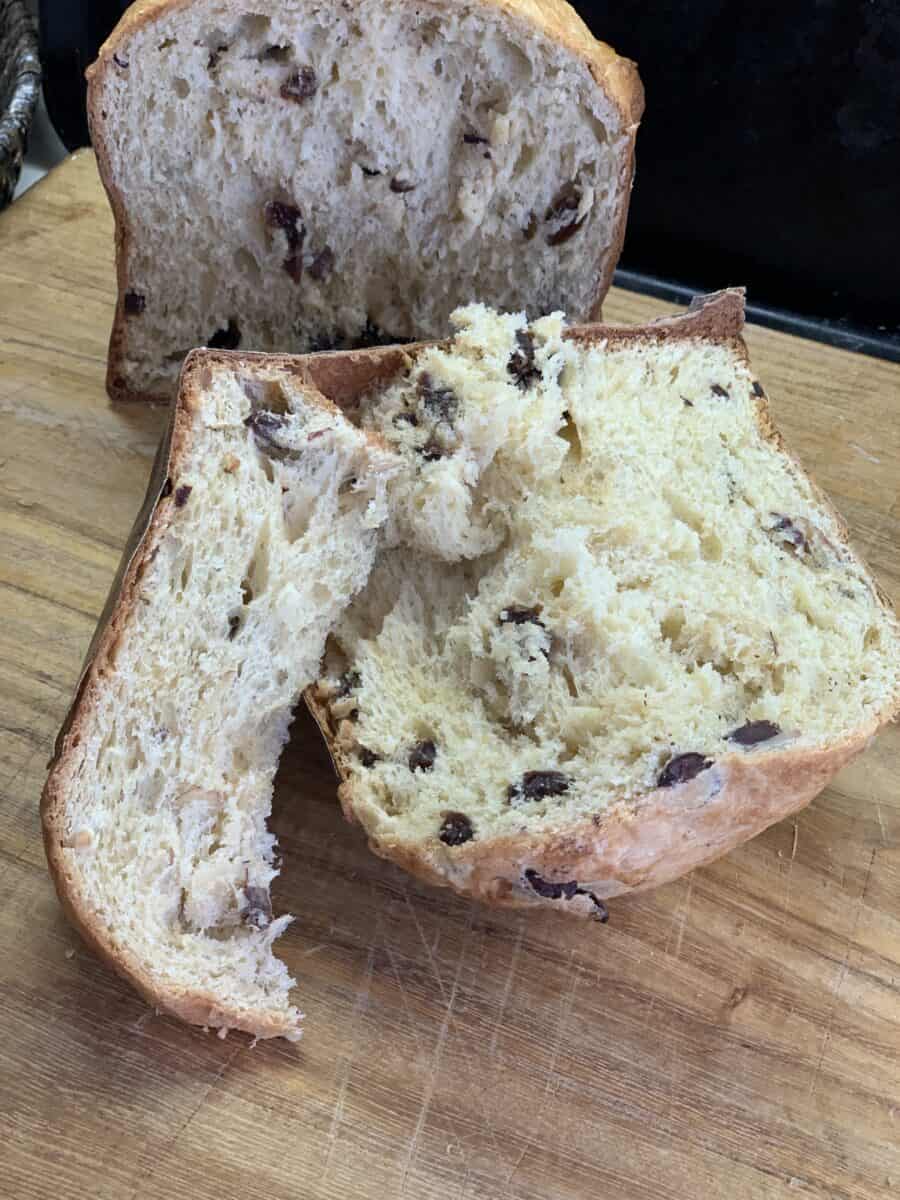
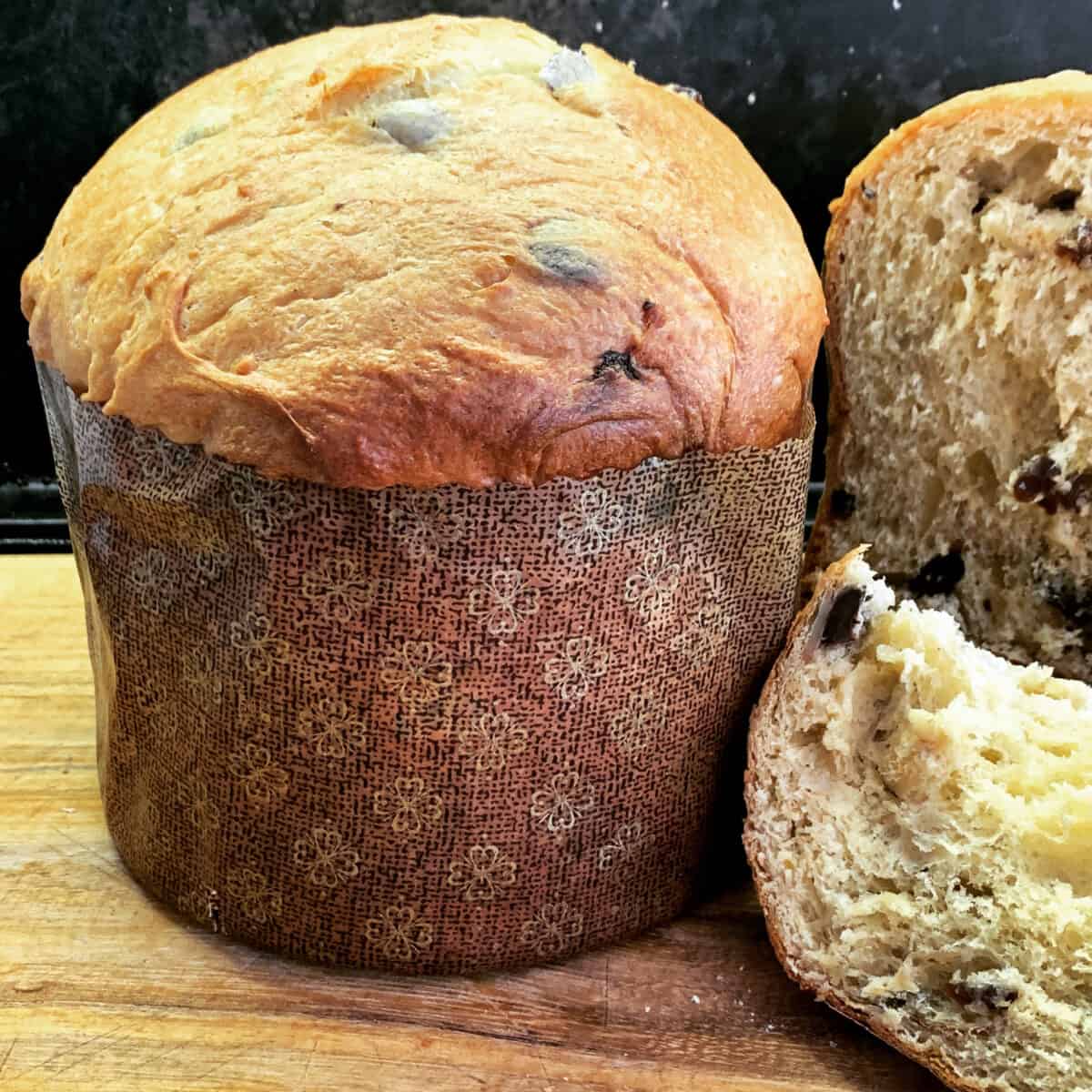
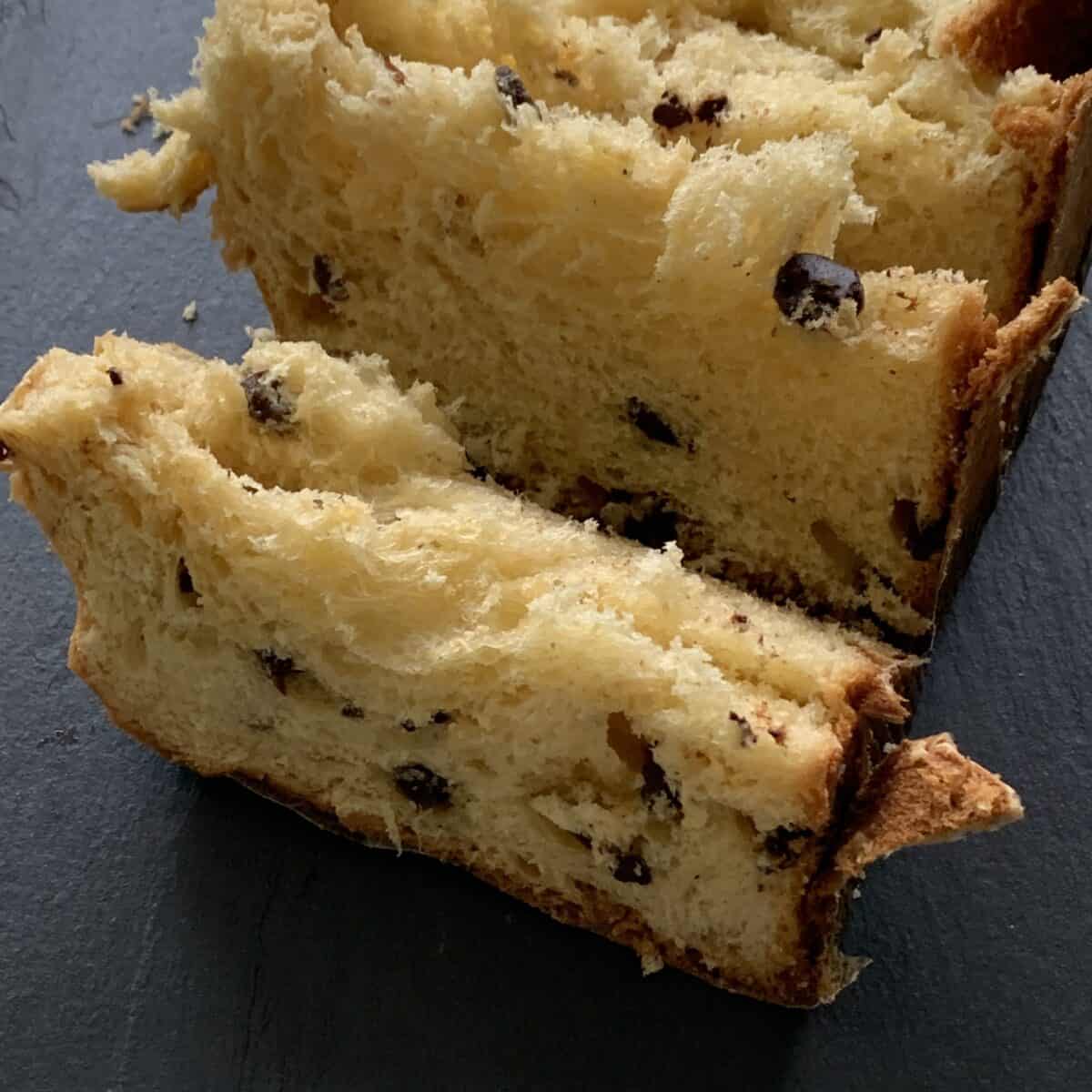
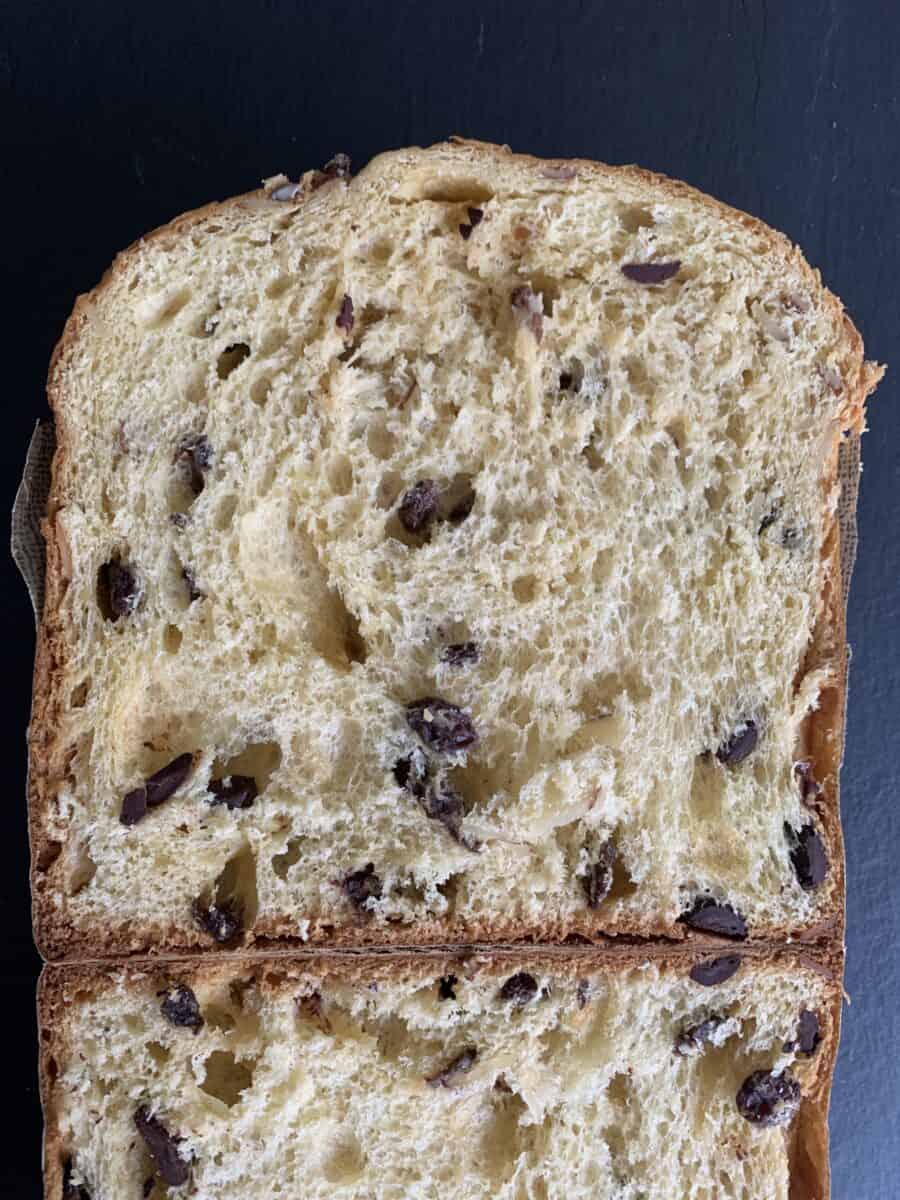
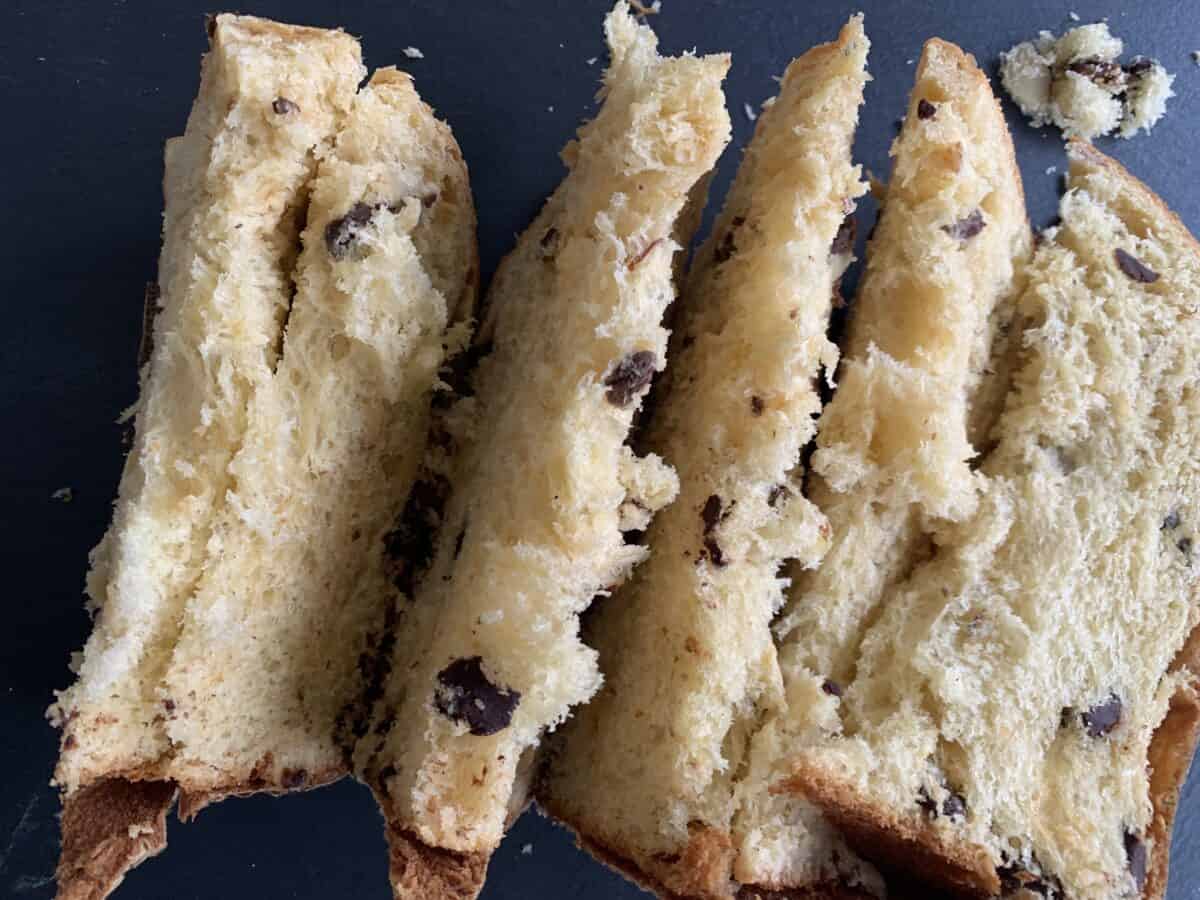
What is 320/350 Flour (W-strength)?
The strength of the flour is important when making panettone because you need a very strong gluten network to support all that butter and all those egg yolks you will be adding.
The figure below is shown in Italian, but it is easy to view the flour strength ratings (ie, W-strength) from low (blue) to high (red).
Low W-strength absorb less water, have lower protein content, and leavens more quickly. Conversely, high-strength flours absorbs more water, take longer to ferment, and have a higher protein content.
Note the corresponding protein content ranges for each W-strength rating:
- 9-10.5% (W90/W130)
- 10-11% (W130/W200)
- 10.5-11.5% (W170/W200)
- 12-12.5% (W220/W240)
- 13% (W300/W310)
- 13.5-15% (W340/W400).
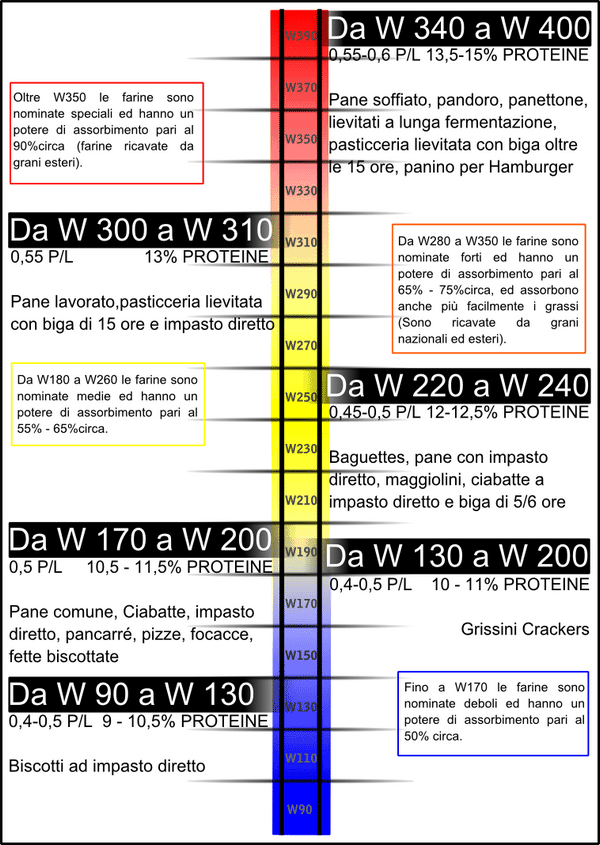
Tips for Making Panettone
- Your starter or levain must be in very good shape and not acidic at all. You must refresh three times during the day of mixing the first dough. Suggested time table is 9AM; 12noon; and 4PM and then make dough at 8PM.
- Some experts recommend it is best to complete three cycles of refreshments (that is, over a total of 3 days, refresh your starter 3 times daily)
- Use the same flour to feed your starter that you do to make your panettone.
- Follow a well tested recipe (Giorilli, Massari, etc).
- Ensure your dough is well kneaded and well developed.
- The dough needs to be strong in order to absorb and carry the fats in the high amounts of butter and egg yolk.
- It may seem like it will take a very long time for the dough to finally come together. At times, I have even let the dough rest a few minutes before continuing to mix.
- Eventually, what seems like a batter will turn into a very soft and wet dough.
- Use the highest quality ingredients, including vanilla bean or real vanilla extract, not imitation.
- Measure out all ingredients before starting so you can concentrate on the dough development.
- Monitor the temperature of the dough!
- The ideal dough temperature is 77 degrees F to a maximum of 82.5 degrees F.
- If the dough temperature rises above 86 degrees F, you risk degrading the gluten.
- If in doubt, place dough in the refrigerator to cool before proceeding. Monitor during the long mix.
- Conversely, dough temperature below 71 to 72 degrees F will result in gluten not developing properly and give you a very slow rise.
- Thank you to LievetoNaturale for these tips!
How Much Dough for Different Sized Panettone Cases/Molds?
There is a fantastic dough calculator available via an Italian website called LievetoNaturale.
This calculator will recommend how much dough to make according to the diameter and height of your panettone mold.
You will be asked to input the diameter of the bottom in centimeters and the height of the mold in centimeters. After inputting these numbers, hit enter. You will see the amount of dough (in grams or kilograms) that is recommended for each size mold.
Please note that the recipe shown below is for 1 kg of dough; you can split it up if you have the appropriately sized smaller liners. Again, use the calculator to figure out what amount of dough you need.
Where to Buy Panettone Cases
- Fante’s
- Amazon
- Walmart
- BakeDeco
- Sur La Table
Storing Panettone
Once the panettone is completely cooked, it should be stored in a polypropylene or cellophane food bag. Otherwise, it will start to harden.
The panettone can be stored for a long period (up to 60 days for some, depending on recipe and the dextrans produced), thanks to natural leavening, but you should spray the inside of the food bag with pure alcohol to reduce the risk of the formation of mold.
Make sure the panettone has been completely cooled and the bag, if sprayed, is completely dry.
Also note that the flavor of the panettone is said to be best approximately 5 days after baking.
Sources: Giallo Zafferano and Lieveto Naturale
How to adjust the amount of dough in the recipe below (if you need more or less)
The following links (in Italian or in English) describe the adjusted amounts to make more or less dough than shown in recipe below (recipe below shows 1 kg of dough).
The links below will give you ingredient amounts for the following sizes of panettone:
- 1 loaf weighing 750 grams.
- 2, 3, or 4 loaves weighing 750 grams each.
- 2, 3 loaves weighing 1000 grams each.
PANETTONE-GIORILLI-DOSI-PIROTTINI (in ITALIAN)
PANETTONE GIORILLI INGREDIENTS BY DOUGH WEIGHT (in ENGLISH)
Other Highly Regarded Panettone Recipes
Note: These are in Italian; use Google translate or other translation services.
- Morandin‘s recipe
- Massari‘s panettone recipe
- Montanari‘s panettone recipe
- Andrea Tortora’s panettone recipe (this seems less labor intensive as far as starter refreshments go and one recipe I would like to try next).
Keep in mind you can make your own homemade lemon paste, which some recipes call for.
Additional Reading on Pasta Madre and Panettone Making
- Some reading that I found helpful on starting and maintaining pasta madre:
- Bake Street
- Staff of Life
- Wild Yeast blog (panettone tips)
- Various posts on the Fresh Loaf including this one.
- Management of natural solid starter (pasta madre) (In italian, you’ll need Google translate)
📖 Recipe
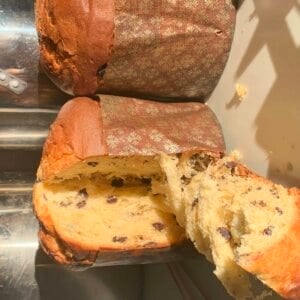
Panettone (Giorilli’s recipe)
Equipment
- Standing mixer
- Panettone cases (some call them liners)
- Skewers to insert into the panettone after baking to invert (prevents collapsing)
- Digital thermometer (highly suggested)
Ingredients
First dough:
- Levain , 50 g (100% hydration) (or 75 g of 45% hydration)
- 75 g sugar (superfine/caster) (see note)
- 120 g water
- 55 g egg yolks (about 3 or 4)
- 75 g butter , softened not melted and cut into several pieces
- 265 g high gluten flour (13.5% to 15% protein) (if using stiffer levain [45% hydration, use 240 g flour)
Second dough:
- 60 g high gluten flour (13.5% to 15% protein)
- All of the aromatic mix (recipe follows)
- 1/2 teaspoon salt (~3 grams)
- 70 g sugar (superfine/caster)
- 95 g egg yolks (about 5 or 6)
- 95 g butter , softened (not melted)and cut into several pieces
- 2 g barley malt (about 1/4 teaspoon)
- 120 g white raisins , soaked
- 60 g candied orange , diced small
- 30 g candied citron , diced small
Aromatic mix:
- 30 g honey
- 1 vanilla bean
- half lemon grated
- half orange grated
Egg wash (optional)
- One egg beaten with a splash of milk or cold water
Instructions
***Day 1***. Overview and Preparation
- Overview of day 1: prepare aromatic mixture (will sit for 24 hours until day 2), soak raisins (soaks for 1.5 hours), refresh levain/starter 3 times throughout morning and afternoon (example, 8AM, noon, and 3PM), and then make first dough in evening (45 mins to 1 hour active time)
Mix Aromatic Blend and Soak Raisins
- To begin, mix ingredients for aromatic blend in a small bowl, cover and let sit for 24 hours
- Rehydrate raisons by soaking them in bowl of hot water for 30 minutes, rinse well and then soak again in warm water for 1 hours. Drain, squeeze out all water, and then place on cloth lined baking sheet and cover with clean dry cloth, and let sit overnight. Make sure to re-weigh raisins once hydrated because you will need less as they will weight more.
Refreshing your Starter/Levain (Liquid)
- Ensure that your levain (liquid or stiff) has been refreshed enough times so that it is very active (suggestion is at least 3 refreshers the day that you are making first dough) (eg, refresh at 8AM, noon, 3PM, and then use some to make first dough at 7PM)
Mixing the First Dough
- When ready to mix the first dough, add the levain to the bowl of a standing mixer, along with flour and water.
- Mix for 10 to 15 minutes, then add sugar and then softened butter in several pieces.
- Only after butter is completely blended, add the egg yolks in several stages.
- Ensure that the dough temperature stays under 26 degrees C (78F). If it goes higher, place dough in freezer for 10 minutes (remember this for second dough too)
- Mix for 25 minutes until you get a silky smooth elastic dough. Test dough for windowpaning.
Bulk Rise of First Dough (12 hours/overnight)
- Place dough in large container (three times the size of the dough), cover, and let rise at 28/30 C (82 to 86F) for 12 hours. You may leave the covered dough inside the oven (turned off!) with the oven light turned on for warmth if you have a cool kitchen.
***Day 2***. Overview and Mixing of Second Dough
- Overview: Make dough two (45 mins), form loaves/rest dough (1 hour), let loaves rise (6 to 9 hours), and bake (35 mins to 1 hour, depending on liner size, see note)
- To begin, consider placing dough/bowl/hook in refrigerator while measuring ingredients for dough two
- When ready to proceed, add flour and barley malt to the day 1 dough and mix at slow speed than medium for 15 minutes
- Slowly incorporate sugar
- Afterwards, add half the egg yolks, salt, and aromatic blend.
- Knead until smooth and homogenous
- Add 70 grams of the softened butter, mix well, and then the rest of the yolks.
- Knead until smooth and then add the remaining butter, the raisins, and the candied fruit.
Bulk Rise of Second Dough
- Remove from machine and let stand in covered bowl for 30 minutes
- Remove dough from bowl and let sit uncovered on counter for 15 minutes
Final Rise of Second Dough
- Divide dough and form into balls sized according to size of the containers/pans/liners you are using (see notes)
- Allow loaves to rise in liners placed on a on baking sheet, covered by plastic wrap at a temp of 28 to 30 C (82 F to 86F) for 8.5 to 9 hours. You may leave the covered dough inside the oven (turned off!) with the oven light turned on for warmth if you have a cool kitchen.
- The dough should rise within 1 inch of top of mold. If it rises more than that, you risk getting a mushroom shaped panettone, which is not considered ideal.
Preparing to Bake
- In the meantime, before baking, pre-heat the oven to 165 C (330 F) and allow panettone to form skin by uncovering for 15 to 20 minutes prior to baking
- Cut a cross on top of panettone prior to baking and add a chunk of butter to the center (see photo collage) If you want shiny loaves, consider brushing top with egg wash
Bake loaves
- Center should read 94 C (201 F) when done (takes about 50 to 55 minutes for 1 kg dough; see note for baking according to size)
Invert and cooling of loaves
- To cool, immediately invert loaves by inserting wooden skewers across bottom and hang upside down on top of deep pot (see photo collage) (NOTE: you should use very pointy skewers or it may be difficult to pierce the panettone liners (I twist them for easy insertion; some folks pre-skewer their liners before baking. The loaves stick to the side of liners so they should not fall out. When serving, it is okay to cut right through paper and peel it off).
- After completely baked, place the loaves in plastic/cellophane bags. Before wrapping in plastic, you must wait 10 to 12 hours for loaves to completely cool. (to reduce risk of mold, consider spraying inside of bags with pure food grade alcohol and dry out completely before using)
- Panettone is best eaten at least 5 days after baking as the flavors continue to develop after baked.
Notes
*Dough should occupy about 1/3 of the panettone liners
**Liner sizes:- 1228 kg dough: 12.5 cm high x 18 cm wide (~6 x 8 inches)
- 964 kg dough: 11 cm high x 17 cm wide (~5 x 8 inches)
- 595 kg dough: 10 cm high x 14 cm wide (~4.5 x 6.5 inches)
- 394 kg dough: 9 cm high x 12 cm wide (~4 x 5.5 inches)
- 100 kg dough: 5 cm high x 7 cm wide (~2.5 x 3 inches)
500 g dough: 35 minutes at 170/180 C (340 F to 360 F)
1000 g dough: 50 to 55 minutes at 170/180 C (340 F to 360 F)
1500 g dough: 70 to 75 minutes at 170/180 C (340 F to 360 F)
2000 g dough: about 90 minutes at 160/170 C (320 F to 340 F) After baking, bread must be immediately skewered and turned upside down to prevent deflating! Leave this way for 10 to 12 hours Variations: Can soak raisins in rum; other dried fruit can be used, ie, cranberries, cherries, etc Source for ordering pannetone liners: Fantes.com

Hi Marie,
Thank you for the recipe. I have tried 3 times. Absolutely loved the soft texture. May I know if there’s a need to knead Dough 2 till windowpane stage? I find Dough 2 very soft. I also find it difficult to cut a cross on the surface of the dough before bake as it is very soft. Did i get Dough 2 right? Appreciate your advice.
Yes, windowpane is important
Hi Marie! I need to bake the panettone in 2 days but ran out of levain or sourdough starter! Is there any way that I can do? If I use malt syrup, how much I should use? Appreciate your advice!
Hi Peggy, unfortunately that’s the most important ingredient BUT you can find panettone recipes that use instant yeast or maybe biga if you search google – they are not authentic but they work in a pinch
Hi Marie
I just made my first successful panettone with a recipe quite similar to yours (it’s from from the Fresh Loaf). I had issues with the mixing of the second dough and am now researching how to make the process more efficient. Is there a “best method” and reason as far as the order of adding the water, butter and egg yolk overall in both doughs?
Hi Patrice, what issues did you have with the second dough? Yes, there is definitely an important order and also important to keep temperature of the dough in mind. If the dough temperature gets too hot, the gluten can break down. Overall, fats like eggs and butter are added only after the dough is sufficiently developed and they are typically added in increments. The recipe here adds eggs after butter but I have seen it the other way around as well. The most important tricks are watching dough temp and also adding fats after dough develops. I hope that helps! Finally a higher protein flour is important. Most info I read says 13.5% to 15%.
I have made Pantettone fatto in casa before, but never with lievito madre. It was my first attempt, and while I made some mistakes preparing the pasta madre for use after refreshments, the panettone still came out great! much more soft and fluffy than the one I made with a biga from yeast. This recipe is a keeper, but I would personally recommend (at least for myself) to preferment the yeast for a couple hours prior to Phase one of making the Panettone.
Your links were very helpful, and being able to read the original Italian was very helpful too (though G Translate does a decent job).
From one Philadelphian to another, fantastic job!
Hi Michael, I’m so glad you liked it! So the pasta madre definitely should be refreshed three times for at least 1 or preferably 2 days before baking. And, the first dough is made after 3 to 4 hours following the last pasta madre refresh – it sounds like maybe that’s not clear in my instructions? I will revisit – thanks so much for your feedback 🙂
The second time I tried the recipe, I ended up taking the pasta madre from the final refesh, and making something like a poolish out of it. borrowed some flour and water from the primo impasto, and made a mix of water and flour (100% hydration) and all of the pasta madre. 2-3 hours in the proofing area and little bubbles begin to form, then I used that with the rest of the ingredients for the primo impasto. The result was a perfectly proofed and dome-shaped primo impasto ready the next morning for making secondo impasto.
I do think, however, that my second dough was a little bit under-developed. While there was some strength in the gluten network, it was very slack, almost like batter. It rose somewhat well, but only rose about 2/3 of the panettone liner. It was a tasty bread, but just a little bit short.
Also, one of the finishing touches you can try is to give it the signature Scarpatura – this recipe gives a really cool guide on how to do it at the end (in Italian – https://www.tavolartegusto.it/ricetta/ricetta-panettone-fatto-in-casa/). It’s definitely an art for that takes some practice!
When mixing the second dough, is the remaining butter supposed to be added together with the raisins and candied fruit at the same time? Or candied fruit to be added after the remaining butter is incorporated?
Is the chunk of butter place on top of the dough softened butter? Or is it okay if it’s cold butter from the fridge?
My panettone sank in the middle when I was baking it in the oven :(. Do you have any idea what might have caused this?
I would wait for the remaining butter to incorporate before adding the raisins and fruit – I’ll clarify that. Yes, I add a cold chunk, I think that’s fine. As far as the sinking, I am not sure – did you open and close oven? Or perhaps the gluten developed enough/was not strong enough to carry the weight of the leavened loaf – what flour did you use?
Thanks Marie! That’s very helpful! I use bread flour :).
How long do you mix the second dough to reach window pane? The dough is very sticky. Does it pull away from the bowl once it reaches window pane?
Yes, the dough will pull away and it should be shiny and silky – it does take a while. I haven’t made any yet this year but looks like it can take up to 45 minutes in the mixer.
Hi, could you tell me a US source for the high protein flour you use for this recipe?
Thankyou
Hi, I have made this with Sir Lancelot (King Arthur) but also you can add gluten to increase the protein content of bread flour. To increase a 12% protein flour to 15%, you are looking at a 3% differences in protein. If you are using 500 grams of flour, you multiply by 3% that give you 15 grams, which is how much vital wheat gluten you’d need to increase the protein content to 15% – I hope that helps! Source: Serious Eats
Hi,
I’m getting this ready – the starter is that made from a pasta madre- if so do you make a levain out of it or just use the pasta madre??
Cheers
I have done it with levain but the better option is definitely pasta madre for sure!
Nice one – cheers
It’s looking good!! Wish I could share a picture
Hi Marie, Thanks for sharing the recipe. I have baked this a few times. It is very delicious and soft. However, it seems to be very moist, both the crust and inside after it is rested overnight. How is the panetonne’s crust and inside supposed to be?
The dough was very soft and sticky so cutting the cross prior to baking is sometimes a challenge. Sometimes, I just snipped it with a pair of scissors instead.
Hi Christy! are you allowing the panettone to form a skin before baking (see “preparing to bake” in the recipe card) – it is hard though and I think scissors are fine. Even try a sharper razor? Work quickly too.
The inside of the panettone is not too moist, I wonder if you need to bake yours a little longer? I would try this first – supposedly panettone is best after it rests a few days but I usually tear right into it!
Hi Marie! Baked it again few days ago. You are right….it was underbaked all these while. Nailed it this time. Thanks for your advice. 🙂
Hi Marie! Thanks for this great guide! If you may, can you clarify whether the barley malt powder/syrup you used was diastatic or non-diastatic? Is it just for flavor or for keeping a steady supply of simple sugars too?
I used non-diastolic and it worked fine. I used the brand “Eden” traditional barley malt syrup. I will have to experiment with using diastolic malt powder – which may be better since this is a long fermented dough…
Hi Marie,
Thanks for such wonderful recipe! Can I adjust the amount of sugar to meet the requirements of a healthy diet? How much sugar can I reduce in order not to affect the nice flavor of this panettone?
Thanks!
Unfortunately panettone recipes are highly technical and there are certain ratios that need to be followed and so I wouldn’t advise it. Maybe just enjoy smaller portions?
HI, thank you for the recipe!
If I use a 4 and 3/8 by 3 and 3/8 inch mould, that will hold rought 320-350 grams. How hot should I bake it at and for how long? Thank you.
Hi Michael sorry, I’m just seeing your question. I see you used the calculator to determine dough needed; looking at the temperatures and times listed in the recipe card, there is an entry for 500 grams of dough but nothing smaller – I’d say start testing at 20 to 25 mins..Using a Thermapen or other baking thermometer, the center of the panettone must read 201 degree F to be finished.
This was my third panettone recipe, and it produced the best results by far! Just be patient. With a cold kitchen, you need to proof for many hours, even overnight.
Sorry, but is there an error in the process described for Dough 1? Shouldn’t the butter be added last and not the yolks? I followed the instructions to the last word and am almost at the end of the 25 min mixing time after adding the yolks – batter (I can’t call it a dough) is lumpy and gloopy and nowhere near windowpane stage.
Hi Rachel, the recipe is correct as written and the yolks do indeed go last – the dough is initially very batter like but after the long mix it turns into a very wet dough. I will post more pictures soon to demonstrate each stage …my guess is that you didn’t mix long enough
Marie, is the amount of egg yolk in the second dough correct? 95g of yolk is not equivalent to 4 yolks. Did you mean 65g instead? And in the chart for the recommended dough weight for different-sized liners, you obviously mixed up kilograms and grams, yes?
Hi Rachel, good catch, thank you!! I always go by weights and the weight measure is indeed correct so I believe it’s more like seven yolks for the second dough. Also, funny about the grams for liner sizes. Yes, it is grams not kilograms😂😂 that said, I have found that I don’t get a nice bloom with those weights of dough per liner size. (As shown in the picture, although the crumb and flavor are still fabulous). I was in the process of updating the site to link to a dough calculator for panettone liners. It’s in Italian but you can easily see the calculator and enter your height and width of your liner. Also, in the post there is a link to a worksheet that gives you different amounts of ingredients for different amounts of dough. That is 750 g, 1 kg, etc. It is also an Italian LOL, I have the translation ready to upload. If you email me I will email you the translated document
Really like to try this recipe but I can’t find any barley malt. Can I just skip it ?
It seems like such a small amount, I’m tempted to say yes, but to be on the safe side you can substitute molasses or maple syrup.
Is that barley malt syrup or powder you use? Exact recipe I’m looking for! Can’t wait to make this for Christmas!
I used the syrup 🙂